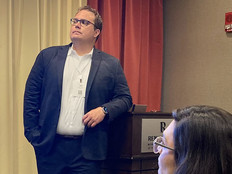Show 'Em the IT
Let’s compare two potential employers. The first employer, on the day after orientation, invites you to pick out your own notebook computer (PC or Mac) and mobile device (BlackBerry, iPhone or Android). They provide you with a 10-gigabyte e-mail account and a password for the internal social network where you can collaborate with colleagues. This employer tells you they trust you to act appropriately on the Internet and has a policy to back it up, but they do not block any sites at work.
The second employer takes a week to provide a standard-issue PC and BlackBerry, an e-mail account of 100 megabytes that barely holds 10 messages (with attachments) and access to a static intranet. They make you sign 10 forms and take numerous training sessions on security and ethics. Essentially, they’re communicating that they do not trust you, and they block all the sites you use to communicate with friends and colleagues (whether it’s Facebook, Twitter or YouTube).
If you haven’t already guessed, the first employer is a technology innovator (in this case, Google) and the second a typical government agency. Talented young tech students fresh out of college want to work in a cutting-edge environment where they receive the best tools to engage in pioneering projects.
The First Wave
Young technologists do not see the federal government as an ideal employer when it comes to technology innovation — despite its expanding use of social media, despite the $72 billion annual IT budget, despite senior IT leaders sitting on the management team of every major agency. On ComputerWorld’s 2009 list of “100 Best Places to Work in IT,” not a single federal agency made the cut. That’s the bad news.
The good news is that it’s a great time to start changing that opinion — and the work has already begun.
For example, the Federal Cyber Corps program offers scholarships for students completing their junior year of undergraduate or first year of graduate school. In exchange, the government gets them for one to two years upon completion of their studies. Cyber Corps has become highly competitive, with its graduates coveted by agencies ranging from the CIA and the National Security Agency to the Homeland Security Department. And the corps’ alumni have built up a robust network for sharing best practices and job opportunities as they rise through the ranks.
In addition, the Obama team, which perfected the use of social media and new technologies to help it win the presidency, brought that people-empowering perspective to the White House. Both CIO Vivek Kundra and Chief Technology Officer Aneesh Chopra are young, innovative thinkers with experience in private-sector startups and in the public sector. They advocate for the adoption of technologies that the next generation is embracing. They have already launched websites, such as Recovery.gov and Data.gov, focused on a transparent, participatory approach to serving up data. They also are eliciting citizen input online through such venues as the president’s “Open for Questions” town hall, the Open Government Initiative blog, and the Recovery Accountability and Transparency Board’s IT dialogue.
Tuning in:
GovTwit, a government Twitter directory, lists
nearly 1,700 tweeters
and upwards of
13 million followers.
Why not use these same technologies to attract the next generation of government technologists? Instead of just expecting applicants to find and use USAJOBS.gov, agencies should recruit in the online spaces where potential applicants spend their time, such as Facebook, YouTube and Twitter. An expert in the use of social media to recruit and retain a multigenerational workforce, fed and Gen X’er Andrew Krzmarzick uses his blog, genshift.com, to pave the path for a next-generation government.
Now is an opportune time for federal recruitment, as the appeal of public service rises amidst a financial meltdown that has diminished the prestige and perceived technical advantages of industry employment. Moreover, the president has re-emphasized the need for a strong and innovative public sector to address the nation’s most pressing challenges, from climate change and healthcare to terrorism. Agencies should tap the talent at top universities by linking to initiatives such as “Call to Serve,” spearheaded by the Partnership for Public Service. Science and technology divisions must reach out to the startup and developer community.
Agencies should focus on the potential for prospective hires to work on teams that tackle challenging projects. Respondents to a recent GovLoop.com poll revealed that more than 60 percent wanted to work for the government not because of benefits or stability, but because they seek high-stakes, mission-oriented projects that affect millions of people every day.
Like Tom Cruise’s character in Jerry Maguire, top technology prospects are shouting, “Show Me the IT!” Are government agencies attentive enough to act quickly before someone else signs their next star performer?






